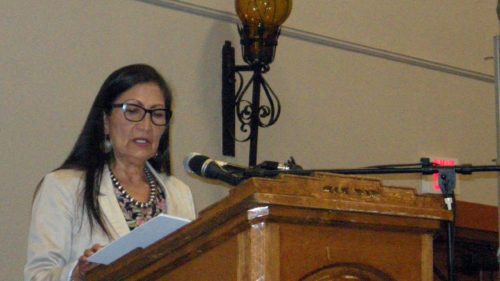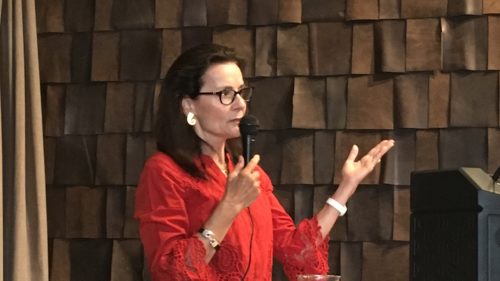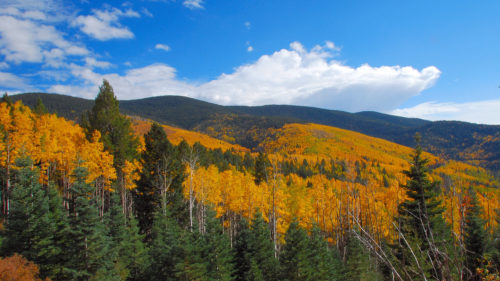By BEN NEARY
NMWF Conservation Director
The New Mexico Department of Game and Fish has been issuing extra licenses for bighorn sheep and other high-demand species to outfitted hunters and nonresidents while commonly failing to give the required percentage of licenses to resident hunters.
Brandon Wynn, an Albuquerque hunter and businessman, has undertaken a detailed analysis of the NMGF license system. He’s a dedicated sheep hunter who applies for hunting licenses in several western states every year.
“I can say this without question: no other state ever issues a single permit in their entire state to a nonresident that they do not absolutely have to issue by law — ever,” Wynn said.
“New Mexico goes out of their way to issue nonresident permits,” Wynn said. “They bend over backwards. They push the limits of the law, they do funny math, they do whatever they can to issue as many outfitted and nonresident permits as possible. I’m 100 percent confident in that.”
A New Mexico law that went into effect in 2012 requires “a minimum of 84 percent of the licenses shall be issued to residents of New Mexico.” The law further species that 10 percent of licenses go to hunters who hire outfitters and 6 percent to nonresident hunters who don’t hire outfitters.
Many other states are far less generous to nonresident hunters. Arizona, for example, requires a minimum of 90 percent of licenses go to residents and sets aside no licenses for outfitted hunters.
The New Mexico law provides detailed instructions on how to calculate the allocation of licenses among the three groups — resident hunters, outfitted hunters and nonresident hunters — in cases where the percentage calculation fails to yield a round number.
The law specifies that when percentage number allocated to a group is five-tenths or greater, the number of licenses issued should be rounded up to the next full number. In cases where it’s less than five-tenths, the law says that the number of licenses should be rounded down.
Conflicts arise often within the statute itself. In order to maintain a minimum 84 percent of licenses for resident hunters, any fractional licenses for residents must always be rounded up to avoid dipping below that quota. But in many instances, the statute’s rounding rules then cannot be followed for the other groups without increasing the total number of available licenses.
The director of the New Mexico Department of Game and Fish has authority to adjust permit numbers by one license per hunt code to comply with the law.
Wynn’s analysis of the 2018 draw results focused on how the NMGF has allocated what it calls the “round-up” licenses, meaning the extra licenses allocated by rounding up to the next whole number.
The game department publishes a hunting proclamation ahead of the draw each year announcing how many licenses it will issue in each hunt code. Wynn’s analysis compared the number of licenses the game department advertised in the 2018 proclamation per hunt code against the number it actually issued as reflected in its published draw results.
Of 728 total hunt codes last year, Wynn found that the game department issued “round-up” licenses that hadn’t been advertised in the proclamation in 176 of them, or 24.2 percent of the hunts.
Of the 176 hunt codes in which the game department issued round-up licenses, Wynn’s analysis found that resident hunters received less than the required 84 percent of the licenses in 166 hunt codes.
Meanwhile, the pool of outfitted hunters received less than its 10-percent quota in only 63 of the 176 hunt codes. Nonresident hunters received less than their 6-percent quota in only 33 of the hunt codes.
In 81 hunt codes last year, both outfitted and resident hunters received more than their quotas at the same time residents received less than their quota, Wynn said.
Bighorn ram licenses commonly bring tens of thousands of dollars around the West at auctions held to benefit conservation programs.
In last year’s game proclamation, the NMGF stated it would issue 25 licenses for Rocky Mountain bighorn rams. More than 7,200 people applied for those licenses: 4,423 residents; 1,447 nonresidents and 1,371 outfitted hunters.
However, the published draw results show that the department actually issued 26 Rocky Mountain bighorn ram licenses — one more than the figure advertised in the proclamation. Of those 26 licenses, residents received 21, outfitted hunters received three and nonresident hunters received two.
The draw results that NMGF published state that resident hunters received the required 84 percent of the bighorn ram licenses. However, the results also state that the game department issued “104 percent” of the total number of ram licenses.
Counting 26 as the true figure representing 100 percent of the bighorn ram licenses issued, New Mexico resident hunters received 80.77 percent; outfitted hunters received 11.54 percent and nonresident hunters received 7.69 percent. Residents were the only applicant pool that received less than their statutory quota percentage.
The game department’s published draw results for last year state that residents got at least 84 percent in all the hunts for various species in which round-up licenses were issued. However, the department counts the “round-up” licenses as taking the total number of licenses above 100 percent. This approach obscures the fact resident hunters are coming up short of their quota on scores of high-demand hunts after the “round-up” licenses are added in.
Wynn said he wants to see the State Game Commission needs to write a rule specifying that the game department must never allow the percentage of resident licenses issued per hunt code to fall below the required 84 percent. And he said the department needs to put the actual number of licenses that it will issue in the proclamation so everybody can see what it’s doing.
“Change the numbers that you’re going to issue,” Wynn said. “Make it transparent. Don’t do it in the dark like this. Don’t try to cover your tracks. Good government is transparent.”
Repeated attempts to reach NMGF Director Michael Sloane for comment on Wynn’s findings were unsuccessful.
Sen. George K. Munoz, D-Gallup, sponsored the legislation that established the 84-percent minimum license allocation for residents. Informed that the NMGF had failed to meet that minimum in 166 out of 728 hunt codes last year, he said he wasn’t pleased.
“I’d love to sue over it,” Munoz said. He said he had talked to several family members and all of them had failed to draw any licenses this year.
Munoz said he hadn’t known that the game department has been routinely issuing more licenses than it lists in the proclamation. “They have to put them in the proclamation for the draw. There’s no, ‘hey, we’re going to hold a tag out,’ right?” he said.
Munoz said he wants to see a complete audit of the NMGF draw system.
“It has to be in the proclamation,” Munoz said of information about licenses. “That clarifies every rule, and every drawing and the number of tags, and if they’re not putting that in the proclamation, how are they advertising that extra tag?”
Wynn said the NMGF has a long history of other actions that benefit outfitted hunters and nonresident hunters at the expense of New Mexico residents.
Wynn noted that after the law requiring the game department to set aside 84 percent of licenses for residents went into effect, the New Mexico State Game Commission and the game department acted quickly to ensure that the law didn’t cut outfitted and nonresident hunters completely out of contention for bighorn sheep licenses.
In 2014, the game commission approved lumping all Rocky Mountain bighorn ram sheep hunts together in a single hunt code. It also lumped all desert bighorn ram sheep hunts together in another hunt code.
There are typically only a few bighorn ram licenses available each year in any particular game management unit. Some of the units are hundreds of miles apart and sheep are hunted in them at various times, often months apart. While hunts in various far-flung game units for other species are considered separate hunts that require separate applications, that’s not the case with bighorn sheep.
If the four bighorn ram licenses available on Wheeler Peak were considered a separate hunt code, outfitted hunters and nonresidents would never draw a license because their percentage of the available licenses would be rounded down to zero. But counting those licenses together with rams in the Latir Peaks, Rio Grande Gorge and elsewhere made the collective pot large enough for outfitted hunters and nonresidents to draw the coveted licenses.
Garrett VeneKlasen, former executive director of the New Mexico Wildlife Federation, addressed the game commission in 2014 when it considered putting all the bighorn ram hunts together under single hunt codes. He warned that the proposal “bends the legal definition of hunt codes.”
“According to state law, a hunt code is the species, weapon type and time frame for a specific hunt,” VeneKlasen told the game commission. “The proposed Rocky Mountain ram hunt code includes seven different herds spanning 400 miles and these seven different time frames.”
VeneKlasen called the proposal to lump all the ram licenses together in a single hunt code, “a gross distortion of state law if not an outright violation of the law.”
Despite that warning, the commission adopted a rule putting all the bighorn ram licenses in one pot so outfitted hunters and nonresidents could continue to draw.
The State Game Commission’s history of helping outfitted hunters and nonresident hunters at the expense of state residents doesn’t stop there, Wynn said.
A Texas hunter named David Terk had secured a federal court order against New Mexico in the 1970s prohibiting the state from imposing quotas on nonresident licenses for bighorn sheep, oryx and ibex. Although a federal law enacted in 2005 established that states could impose such quotas, New Mexico didn’t ask the courts to overturn the Terk injunction in response to the federal law until 2013.
Wynn said the game commission’s eight-year delay in asking the federal courts to overturn the Terk decision after the federal law went into effect resulted in nonresident hunters drawing more than 60 extra bighorn licenses that they wouldn’t have received if the commission had acted to impose quotas as soon as the federal law was passed.
Wynn said he finds it telling that the State Game Commission sat on its hands for eight years after the federal law was enacted without addressing the Terk issue when that delay harmed resident hunters. Meanwhile, the commission acted quickly to help outfitted- and nonresident hunters secure sheep tags after the 84-percent quota law went into effect.
An attempt to reach former Game Commission Chairman Paul Kienzle for comment wasn’t immediately successful. Former Gov. Susana Martinez appointed Kienzle, an Albuquerque lawyer, to the commission in 2012. He resigned as chairman earlier this year at the request of Gov. Michelle Lujan Grisham.
Wynn said he believes that outfitters in the state have had a disproportionate influence over the game commission in recent years. He said outfitters commonly emphasize that their operations create jobs in the state.
“But with wildlife, you’re dealing with a public trust issue, too,” Wynn said. “The wildlife is owned by the citizens of New Mexico. So how do you balance the economic development of the outfitting business with the public trust that’s owned by the citizens of New Mexico?”
Wynn said he would favor eliminating the provision of the state law that sets aside a percentage of licenses for outfitted hunters. He said he would favor a new system dedicating a flat 15 percent of licenses to nonresident hunters. He said outfitters would be free to recruit their clients from that pool.
Gov. Lujan-Grisham has yet to appoint new game commissioners.
Once a new commission is empaneled, Wynn said he would like to see it write a rule immediately specifying that the state will never go below its established quota for resident hunting licenses. And Wynn said he believes “round-up” licenses should be allowed for nonresident or outfitted applicants only to the extent that issuing them would not result in exceeding the published number of licenses.
Wynn said he would like to see many resident hunters attend the first meeting of the new State Game Commission and demand changes to the current system.
Jesse Deubel, executive director of the New Mexico Wildlife Federation, said the organization is committed to seeing residents get their fair share of hunting licenses under the law.
“We’re eager to begin work from a clean slate with a new game commission to ensure that the residents of New Mexico are our state’s top priority,” Deubel said.



